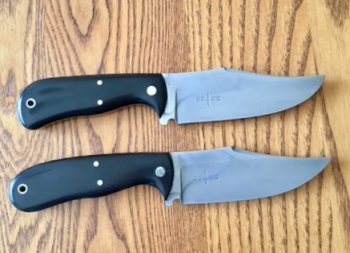johnnyjump
Well-Known Member
I’m working on a series of five knives from the same pattern, and applying the same heat treat with each knife. The blades are 1095, and were brought up to 1475 degrees in the kiln and quenched horizontally in an electric turkey fryer and peanut oil that had been preheated to 120 degrees.The attached photo shows the two blades after etching in a 70/30 mix of ferric chloride and apple vinegar and handles fitted. The edge retention and hardening on both blades is very good. My theory is that the horizontal quench caused the blade to harden differently, with the thicker part showing the Hamon line. Any other ideas? Thanks.

